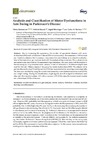Identificador persistente para citar o vincular este elemento:
https://accedacris.ulpgc.es/jspui/handle/10553/70136
| Campo DC | Valor | idioma |
|---|---|---|
| dc.contributor.author | Steinmetzer, Tobias | en_US |
| dc.contributor.author | Maasch, Michele | en_US |
| dc.contributor.author | Bönninger, Ingrid | en_US |
| dc.contributor.author | Travieso González, Carlos Manuel | en_US |
| dc.date.accessioned | 2020-02-05T12:52:37Z | - |
| dc.date.available | 2020-02-05T12:52:37Z | - |
| dc.date.issued | 2019 | en_US |
| dc.identifier.issn | 2079-9292 | en_US |
| dc.identifier.other | Scopus | - |
| dc.identifier.other | WoS | - |
| dc.identifier.uri | https://accedacris.ulpgc.es/handle/10553/70136 | - |
| dc.description.abstract | Due to increasing life expectancy, the number of age-related diseases with motor dysfunctions (MD) such as Parkinson’s disease (PD) is also increasing. The assessment of MD is visual and therefore subjective. For this reason, many researchers are working on an objective evaluation. Most of the research on gait analysis deals with the analysis of leg movement. The analysis of arm movement is also important for the assessment of gait disorders. This work deals with the analysis of the arm swing by using wearable inertial sensors. A total of 250 records of 39 different subjects were used for this task. Fifteen subjects of this group had motor dysfunctions (MD). The subjects had to perform the standardized Timed Up and Go (TUG) test to ensure that the recordings were comparable. The data were classified by using the wavelet transformation, a convolutional neural network (CNN), and weight voting. During the classification, single signals, as well as signal combinations were observed. We were able to detect MD with an accuracy of 93.4% by using the wavelet transformation and a three-layer CNN architecture. | en_US |
| dc.language | eng | en_US |
| dc.relation.ispartof | Electronics (Switzerland) | en_US |
| dc.source | Electronics (Switzerland) [ISSN 2079-9292], v. 8 (12), p. 1-15 | en_US |
| dc.subject | 3314 Tecnología médica | en_US |
| dc.subject.other | Gait Analysis | en_US |
| dc.subject.other | Inertial Sensors | en_US |
| dc.subject.other | Machine Learning | en_US |
| dc.subject.other | Parkinson’S Disease | en_US |
| dc.subject.other | Wavelet Transformation | en_US |
| dc.subject.other | Wearable Sensors | en_US |
| dc.title | Analysis and classification of motor dysfunctions in arm swing in parkinson’s disease | en_US |
| dc.type | info:eu-repo/semantics/article | en_US |
| dc.type | Article | en_US |
| dc.identifier.doi | 10.3390/electronics8121471 | en_US |
| dc.identifier.scopus | 85076025107 | - |
| dc.identifier.isi | 000506678200097 | - |
| dc.contributor.authorscopusid | 57204115368 | - |
| dc.contributor.authorscopusid | 57212143523 | - |
| dc.contributor.authorscopusid | 56395430400 | - |
| dc.contributor.authorscopusid | 6602376272 | - |
| dc.identifier.eissn | 2079-9292 | - |
| dc.identifier.issue | 12 | - |
| dc.relation.volume | 8 | en_US |
| dc.investigacion | Ingeniería y Arquitectura | en_US |
| dc.type2 | Artículo | en_US |
| dc.contributor.daisngid | 34756291 | - |
| dc.contributor.daisngid | 34775863 | - |
| dc.contributor.daisngid | 7765108 | - |
| dc.contributor.daisngid | 265761 | - |
| dc.description.numberofpages | 15 | en_US |
| dc.utils.revision | Sí | en_US |
| dc.contributor.wosstandard | WOS:Steinmetzer, T | - |
| dc.contributor.wosstandard | WOS:Maasch, M | - |
| dc.contributor.wosstandard | WOS:Bonninger, I | - |
| dc.contributor.wosstandard | WOS:Travieso, CM | - |
| dc.date.coverdate | Diciembre 2019 | en_US |
| dc.identifier.ulpgc | Sí | en_US |
| dc.contributor.buulpgc | BU-TEL | en_US |
| dc.description.sjr | 0,303 | |
| dc.description.jcr | 2,412 | |
| dc.description.sjrq | Q2 | |
| dc.description.jcrq | Q2 | |
| dc.description.scie | SCIE | |
| item.fulltext | Con texto completo | - |
| item.grantfulltext | open | - |
| crisitem.author.dept | GIR IDeTIC: División de Procesado Digital de Señales | - |
| crisitem.author.dept | IU para el Desarrollo Tecnológico y la Innovación | - |
| crisitem.author.dept | Departamento de Señales y Comunicaciones | - |
| crisitem.author.orcid | 0000-0002-4621-2768 | - |
| crisitem.author.parentorg | IU para el Desarrollo Tecnológico y la Innovación | - |
| crisitem.author.fullName | Travieso González, Carlos Manuel | - |
| Colección: | Artículos | |
Citas SCOPUSTM
10
actualizado el 08-jun-2025
Citas de WEB OF SCIENCETM
Citations
9
actualizado el 08-jun-2025
Visitas
101
actualizado el 09-mar-2024
Descargas
53
actualizado el 09-mar-2024
Google ScholarTM
Verifica
Altmetric
Comparte
Exporta metadatos
Los elementos en ULPGC accedaCRIS están protegidos por derechos de autor con todos los derechos reservados, a menos que se indique lo contrario.
